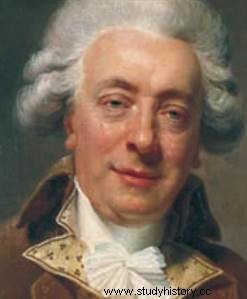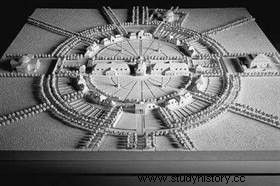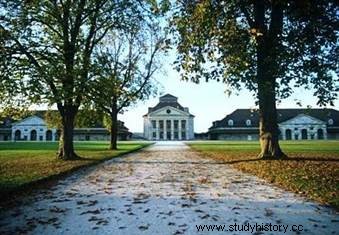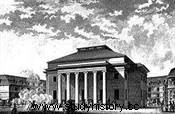 Claude Nicolas Ledoux , architect of neoclassical art and visionary of the Age of Enlightenment , by cubism, surrealism is recognized today as one of the very first architects of its time. Inspired by antiquity, he draws volumes with a precise and balanced geometry. His credo was the well-being of man in a healthy organization of work. Precursor of the utopian movement, he has become a myth. Pierre Kast immortalized it in his film "The Cursed Architect" in 1953 and in his novel "Happiness or Power".
Claude Nicolas Ledoux , architect of neoclassical art and visionary of the Age of Enlightenment , by cubism, surrealism is recognized today as one of the very first architects of its time. Inspired by antiquity, he draws volumes with a precise and balanced geometry. His credo was the well-being of man in a healthy organization of work. Precursor of the utopian movement, he has become a myth. Pierre Kast immortalized it in his film "The Cursed Architect" in 1953 and in his novel "Happiness or Power".
The beginnings of Claude Nicolas Ledoux
Ledoux was born in 1736 in Champagne. First a student at the College de Beauvais in Paris, he then studied architecture at the school of Jacques François Blondel. In contact with members of the Royal Academy of Architecture, he was called upon to fit out an apartment in the mansion of Baron Crozat de Thiers, place Vendôme. Inspired by Trouard returning from Rome, his buildings will have an antique aesthetic, with lots of columns. In 1764, he built a fairly colossal mansion in the Palladian style for President Hocquart on the Chaussée d'Antin. Three years later, he was entrusted with the restructuring of the Hôtel d'Uzès rue Montmartre, of which you can get a glimpse of the woodwork of the company lounge at the Carnavalet museum.
While being appointed architect-engineer of Waters and Forests in 1764, he continued to document himself and traveled to England between 1769 and 1771 where he became familiar with Palladianism (architecture Venetian) and the Serlian (three bay windows whose central is topped by an arch). Many buildings made by Ledoux are in this same Palladian style, adorned with a peristyle, such as the pavilion of Madame du Barry in Louveciennes, inaugurated in September 1771.
Rising through the ranks, and especially because the nobility began to run out of money, as well as under the protection of Madame du Barry, he rose to the post of commissioner at the Salines de l 'Est, then was appointed inspector of the Saltworks of Lorraine and Franche Comté, finally he entered the Royal Academy of Architecture in 1773 thus becoming the king's architect and architect of the Ferme Générale where he was able to build a salt loft in Compiègne.
His dream:the town of Chaux
 As early as 1773, Ledoux was thinking, drawing, modifying and constantly perfecting the plans for his ideal city:the city of Lime, named after the nearby forest. After several plans presented to Turgot, they are accepted by Louis XV and Trudaine. The realization can begin, Ledoux is finally at the head of "his site" at the Royal Saltworks of Arc et Senans, until 1779. In his ideal city, he aspired to create an environment with a rational and hierarchical organization of work , made for people and for their work, an innovative conception of architecture intended to make society a better place. A town in the countryside, located between the La Loue river and the forest. According to the principles of Rousseau "man is perfectible and if he is corrupted, it is by the immorality inherent in urban societies". What was needed then was a “green” city, with plantations aligned in three rows, bordering the roads of the province, and buildings integrated into nature to the best of their environment.
As early as 1773, Ledoux was thinking, drawing, modifying and constantly perfecting the plans for his ideal city:the city of Lime, named after the nearby forest. After several plans presented to Turgot, they are accepted by Louis XV and Trudaine. The realization can begin, Ledoux is finally at the head of "his site" at the Royal Saltworks of Arc et Senans, until 1779. In his ideal city, he aspired to create an environment with a rational and hierarchical organization of work , made for people and for their work, an innovative conception of architecture intended to make society a better place. A town in the countryside, located between the La Loue river and the forest. According to the principles of Rousseau "man is perfectible and if he is corrupted, it is by the immorality inherent in urban societies". What was needed then was a “green” city, with plantations aligned in three rows, bordering the roads of the province, and buildings integrated into nature to the best of their environment.
La Saline is the heart of an ideal city, drawn in a circle around the factory. On the straight line, the administrative buildings are in the center with the director's pavilion and the chapel, so the workers remained in their "little town" even for the office. Opposite the Director's House is the guard building. On each side, in an arc, the farriery, the salt tax, the cooperage, the forge, the clerk and the dwellings of the workers called the berniers. Each worker had a small vegetable garden.
In this ideal city, everyone had to be seen:the director by the employees; employees by the director.
In his project, which aims to be modern, he did not include a prison. He thought that the natural-vegetable or mineral environment must allow the man responsible for his acts to meditate on their consequence, to repent and to amend himself. In this he used Rousseau's principle "man is perfectible, capable of perfecting himself through his own experiences, through his own sensations".
Ledoux at the General Farm
Among his achievements he took care of mansions, opera houses, prisons. But always buildings necessary for social life such as the covered market, the public baths, the gymnastics house, universities, hospices, convalescent home, tolerance, the panaretheon or temple of virtue, the pacifer or temple of peace.
 Still in his role as architect at the Ferme Générale, thanks to Lavoisier's idea, he occupies the surrounding wall of Paris, named "wall of the farmers general" comprising sixty pavilions of grants. This barrier of twenty four kilometers made it possible to limit smuggling. Ledoux produced buildings called "the propylaea of Paris", the architecture resembling a rotunda sometimes surmounted by a cross, or taking the form of a Greek temple, a column, another inspired by the Du Barry pavilion, but all of these works were based on Greek Doric. Fifty barriers were built between 1785 and 1788, then destroyed in the 19th century. But Ledoux was not liked:Louis Sébastien Mercier in his Tableau de Paris had these words “the dens of the taxman metamorphosed into a palace with columns”, and exclaimed:“Ah! Monsieur Ledoux, you are a terrible architect! ". Thus Ledoux was removed from office in 1787.
Still in his role as architect at the Ferme Générale, thanks to Lavoisier's idea, he occupies the surrounding wall of Paris, named "wall of the farmers general" comprising sixty pavilions of grants. This barrier of twenty four kilometers made it possible to limit smuggling. Ledoux produced buildings called "the propylaea of Paris", the architecture resembling a rotunda sometimes surmounted by a cross, or taking the form of a Greek temple, a column, another inspired by the Du Barry pavilion, but all of these works were based on Greek Doric. Fifty barriers were built between 1785 and 1788, then destroyed in the 19th century. But Ledoux was not liked:Louis Sébastien Mercier in his Tableau de Paris had these words “the dens of the taxman metamorphosed into a palace with columns”, and exclaimed:“Ah! Monsieur Ledoux, you are a terrible architect! ". Thus Ledoux was removed from office in 1787.
Everything came to a halt during the Revolution, when the first blows of the pickaxe were given. The granting was abolished in May 1791, and the buildings became useless. Despite everything, there are still those of La Villette, Place Denfert-Rochereau, the Monceau pavilion and that of Place des Nations.
Under the Terror, he was imprisoned in the prison of the Force for eighteen months, "smelling too rich". Once released, he no longer had any architectural projects and began writing his book "Architecture considered in relation to art, customs and legislation" accompanied by drawings he had sketched in 1773 , but constantly retouched and modified according to the evolution of its style of architecture. The work was published two years before his death in 1806. This work focused on the thoughts of the architect in order to obtain buildings always with a view to a harmonious society.
A utilitarian conception of architecture
 The city-factory of the royal saltworks of Arc-et-Senans was built by Claude Nicolas Ledoux between 1775 and 1779. Since 1970, its buildings have housed the International Center for Reflection on the Future. The director's house, whose entrance is adorned with a pediment supported by bossed columns, is located at the point of convergence of the various paths that run through the semi-circular plan. the city is today the only museum in the world dedicated to Claude Nicolas Ledoux
The city-factory of the royal saltworks of Arc-et-Senans was built by Claude Nicolas Ledoux between 1775 and 1779. Since 1970, its buildings have housed the International Center for Reflection on the Future. The director's house, whose entrance is adorned with a pediment supported by bossed columns, is located at the point of convergence of the various paths that run through the semi-circular plan. the city is today the only museum in the world dedicated to Claude Nicolas Ledoux
Sixty models are exhibited, tracing the projects of this architect. Some were born, but destroyed by time and men, others remained only at the project stage. You can discover theatres, mansions, a prison, etc.). Some are utopian, such as the town of Chaux, a house of pleasure, industrial buildings.
The Château de Bénouville is the major building created by Ledoux between 1769 and 1778. Built for the Marquis de Livry, located near Caen, the two facades have Ionic columns enclosing spans on three levels. On the garden side, the bas-reliefs are embellished with warrior trophies. Inside, the majestic and colossal central staircase leads to the first two levels with wide corridors.
The Hôtel Guimard, built between 1770 and 1772, was donated by Marshal de Soubise to Mademoiselle Guimard, first dancer at the Opera. Located in the Chaussée d'Antin district, it is a kind of asymmetrical cube, with a winter garden in the center. Ledoux had even imagined installing a private theater above this central garden and had called on renowned artists for the decoration, such as Fragonard. This hotel of great refinement really made him known.
 Constantly in the Doubs region, Ledoux was chosen to build the theater in Besançon, a town of thirty two thousand inhabitants having no such building. This was a first in the design, the custom being that only the nobles were seated and the people remained standing. According to the Roman model with hemicycle and bleachers, Ledoux thus provided for the “parterre” provided with armchairs for the subscribers, the officers installed on the first balcony, the nobles in the first boxes and the bourgeoisie in the seconds; finally the people could settle down on seats in the amphitheater. Ledoux was again the first to create the orchestra pit. The theater was inaugurated in 1784, unfortunately destroyed in April 1958 during a fire, but was never rebuilt like this.
Constantly in the Doubs region, Ledoux was chosen to build the theater in Besançon, a town of thirty two thousand inhabitants having no such building. This was a first in the design, the custom being that only the nobles were seated and the people remained standing. According to the Roman model with hemicycle and bleachers, Ledoux thus provided for the “parterre” provided with armchairs for the subscribers, the officers installed on the first balcony, the nobles in the first boxes and the bourgeoisie in the seconds; finally the people could settle down on seats in the amphitheater. Ledoux was again the first to create the orchestra pit. The theater was inaugurated in 1784, unfortunately destroyed in April 1958 during a fire, but was never rebuilt like this.
Always in public buildings, he worked on the construction of the courthouse and the prison of Aix en Provence. Work began in 1786 barely reaching the height of the ground floor but everything was interrupted during the French Revolution.
A monument is erected in memory of Ledoux on the Jura area when you take the A39:Porte de Bourneville or the Pavillon des Cercles. The Circles workshop or Coopers workshop, imagined by Ledoux, represents two intertwined barrels, the strapping being metallic to enclose the salt barrels. In his ideal city, the workshop had to be placed in the center of the four roads. Manufacturing on the ground floor and workers' accommodation upstairs.
To go further
- Architecture considered in relation to art, mores and legislation:Writings and remarks on art, by Nicolas Ledoux. Hermann, 2014.
- The Claude-Nicolas Ledoux model museum:Royal Saltworks of Arc-et-Senans, by Dominique Massounie. Hartpon, 2017.
- The Château de Bénouville:A work by Claude-Nicolas Ledoux, by Dominique Pain. Notebooks of Time, 2007.
